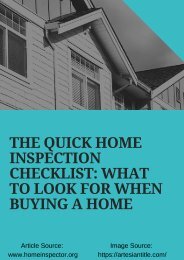10 STEPS TO BUYING A HOME
You also want an ePaper? Increase the reach of your titles
YUMPU automatically turns print PDFs into web optimized ePapers that Google loves.
<strong>10</strong> <strong>STEPS</strong><br />
<strong>TO</strong> <strong>BUYING</strong><br />
A <strong>HOME</strong><br />
U N D E R S T A N D I N G H O W T O F I N D A N D<br />
F I N A N C E T H E P E R F E C T H O M E F O R<br />
Y O U<br />
B U Y I N G A H O U S E R E Q U I R E S A L O T<br />
O F T I M E A N D E F F O R T , B U T T H E S E<br />
1 0 S T E P S C A N H E L P M A K E T H E<br />
H O M E B U Y I N G P R O C E S S<br />
M A N A G E A B L E A N D H E L P Y O U M A K E<br />
T H E B E S T D E C I S I O N S P O S S I B L E .<br />
https://www.discover.com/<br />
https://artesiantitle.com/
Step 1: Start Your Research Early<br />
As soon as you can, start reading Web sites, newspapers, and magazines that have real estate listings.<br />
Make a note of particular homes you are interested in and see how long they stay on the market. Also,<br />
note any changes in asking prices. This will give you a sense of the housing trends in specific areas.<br />
Step 2: Determine How Much House You Can Afford<br />
Lenders generally recommend that people look for homes that cost no more than three to five times their<br />
annual household income if the home buyers plan to make a 20% down payment and have a moderate<br />
amount of other debt.<br />
But you should make this determination based on your own financial situation. Use our Affordability<br />
Calculator to see how much house you can afford.<br />
Step 3: Get Prequalified and Preapproved for credit for Your Mortgage<br />
Before you start looking for a home, you will need to know how much you can actually spend. The best<br />
way to do that is to get prequalified for a mortgage. To get prequalified, you just need to provide some<br />
financial information to your mortgage banker, such as your income and the amount of savings and<br />
investments you have. Your lender will review this information and tell you how much we can lend you.<br />
This will tell you the price range of the homes you should be looking at. Later, you can get preapproved<br />
for credit, which involves providing your financial documents (W-2 statements, paycheck stubs, bank<br />
account statements, etc.) so your lender can verify your financial status and credit.<br />
Step 4: Find the Right Real Estate Agent<br />
Real estate agents are important partners when you’re buying or selling a home. Real estate agents can<br />
provide you with helpful information on homes and neighborhoods that isn’t easily accessible to the<br />
public. Their knowledge of the home buying process, negotiating skills, and familiarity with the area you<br />
want to live in can be extremely valuable. And best of all, it doesn’t cost you anything to use an agent –<br />
they’re compensated from the commission paid by the seller of the house.<br />
Step 5: Shop for Your Home and Make an Offer<br />
Start touring homes in your price range. It might be helpful to take notes (using this helpful checklist) on<br />
all the homes you visit. You will see a lot of houses! It can be hard to remember everything about them,<br />
so you might want to take pictures or video to help you remember each home.<br />
Step 6: Get a Home Inspection<br />
Typically, purchase offers are contingent on a home inspection of the property to check for signs of<br />
structural damage or things that may need fixing. Your real estate agent usually will help you arrange to<br />
have this inspection conducted within a few days of your offer being accepted by the seller. This<br />
contingency protects you by giving you a chance to renegotiate your offer or withdraw it without penalty<br />
if the inspection reveals significant material damage.
Step 7: Work with a Mortgage Banker to Select Your Loan<br />
Lenders have a wide range of competitively priced loan programs and a reputation for<br />
exceptional customer service. You will have many questions when you are purchasing a home,<br />
and having one of our experienced, responsive mortgage bankers assist you can make the<br />
process much easier.<br />
Every home buyer has their own priorities when choosing a mortgage. Some are interested in<br />
keeping their monthly payments as low as possible. Others are interested in making sure that<br />
their monthly payments never increase. And still others pick a loan based on the knowledge they<br />
will be moving again in just a few years.<br />
Step 8: Have the Home Appraised<br />
Lenders will arrange for an appraiser to provide an independent estimate of the value of the<br />
house you are buying. The appraiser is a member of a third party company and is not directly<br />
associated with the lender. The appraisal will let all the parties involved know that you are paying<br />
a fair price for the home.<br />
Step 9: Coordinate the Paperwork<br />
As you can imagine, there is a lot of paperwork involved in buying a house. Your lender will<br />
arrange for a title company to handle all of the paperwork and make sure that the seller is the<br />
rightful owner of the house you are buying.<br />
Step <strong>10</strong>: Close the Sale<br />
At closing, you will sign all of the paperwork required to complete the purchase, including your<br />
loan documents. It typically takes a couple of days for your loan to be funded after the paperwork<br />
is returned to the lender. Once the check is delivered to the seller, you are ready to move into<br />
your new home!


















